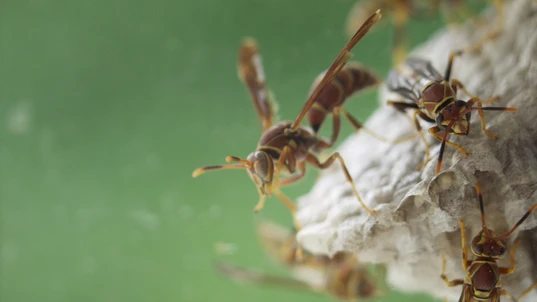All About Paper Wasps in Australia

Bites and Stings

The Paper wasp is common throughout Australian homes, gardens, and bushland. Important to native ecosystems, Paper wasps have been known to aggressively defend their nests when threatened and cause painful stings.
The Australian Paper wasp is a common wasp species that inhabits homes, gardens and bushlands. One of the roughly 12,000 wasp species in Australia, Paper wasps play an important role as pollinator in the Australian ecosystem. Paper wasps are native to Australia and are distinguished by their inverted cone-shaped nests, found under the eaves of houses and in trees. Unlike bees, wasps can issue multiple painful stings at any one time. Wasps will aggressively swarm and attack if their nest is threatened. Paper wasps can give a painful sting and some people can respond with a severe allergic reaction. Continue reading to find out more about Paper wasps (Polistes humilis) and how to treat their stings. We also cover insect bites in the following first aid courses: Head to our website to enrol in a course near you - we have locations all across Australia.Appearance
Australian Paper wasps have a reddish brown body with some yellow or orange bands. Likewise, they have a slender build, narrow waist, and tend to range from 10 - 15 mm long. They are commonly misidentified for Asian Paper wasps. However, Australian Paper wasps tend to be smaller than their Asian counterpart and have less distinct banding.Habitat
Paper wasps live in heathlands, urban areas, and forests and woodlands throughout Australia, including:- Southern Queensland
- New South Wales
- Victoria
- South Australia
- Southern Western Australia
Looking to get you First Aid knowledge up to date?
We run certified First Aid courses throughout all major Acustralian citys. Find a location near you.
Habits
Adult Paper wasps eat nectar, though they collect caterpillars to feed their larvae. As such, they play an important part of pollinating along with keeping garden insects under control. Paper wasps are not as aggressive as their European counterparts, however, they can be aggressive when defending their nests. There are more than 35 species of native Paper wasp, and each has a distinctive nest design.
Though Australian Paper wasps are not as outwardly aggressive as European wasps, they will likely swarm and sting any threats to their nest. Their stings can cause symptoms ranging from pain and itching to severe allergic reactions (anaphylaxis).
Danger to humans
Paper wasps are not venomous but will give a nasty sting if their nest is threatened. They attack as a swarm, and as Paper wasps give multiple stings it is important to exercise caution if you come across a nest. Paper wasps are an important part of the native ecosystem, they are not considered a pest, but are more likely to keep other small annoying insects at bay. If you are concerned about a Paper wasp colony, call a professional to remove it. Paper wasps tend to return to the location of their nests if it is simply destroyed. If stung, most people will experience mild symptoms like pain, itching, and swelling at the sting site. Allergic casualties, however, may experience more severe symptoms like:- Wheezing and breathing difficulties
- Facial swelling and hives
- Abdominal pain and vomiting
First aid for wasp stings
Unlike a bee sting, a wasp sting will not remain in the skin. They can sting multiple times without dying. Paper wasps will swarm when their nest is under attack or threatened. Care and treatment for a wasp sting goes like so:- Calm and reassure the casualty
- Wash the sting site with soap and water to remove some of the venom
- Apply a cold compress to the sting site to reduce pain and swelling
- Apply hydrocortisone cream or calamine lotion to the sting site to ease redness, itching, or swelling
- Monitor the casualty for signs of an allergic reaction. If they do begin experiencing a severe allergic reaction, call Triple Zero (000) for an ambulance, consult the Australian Resuscitation Council's anaphylaxis treatment guideline, and follow DRSABCD and prepare to perform CPR
Final thoughts
The Australian Paper wasp is an important pollinator and contributor to the Australian ecosystem. While they are not as aggressive, nor considered a pest like the European Wasp, they can give a nasty sting if under threat. If stung, most people will experience mild symptoms like pain, itching, and swelling at the sting site. Seek medical immediate medical help if any symptoms of anaphylaxis occur. If you are interested in learning more about first aid for insect bites, enrol in one of our first aid courses: Head to our website find a course near you - we have locations all across Australia.
Originally published at
https://www.australiawidefirstaid.com.au/resources/paper-wasp-australia
as part of the Australia Wide First Aid Articles Library









